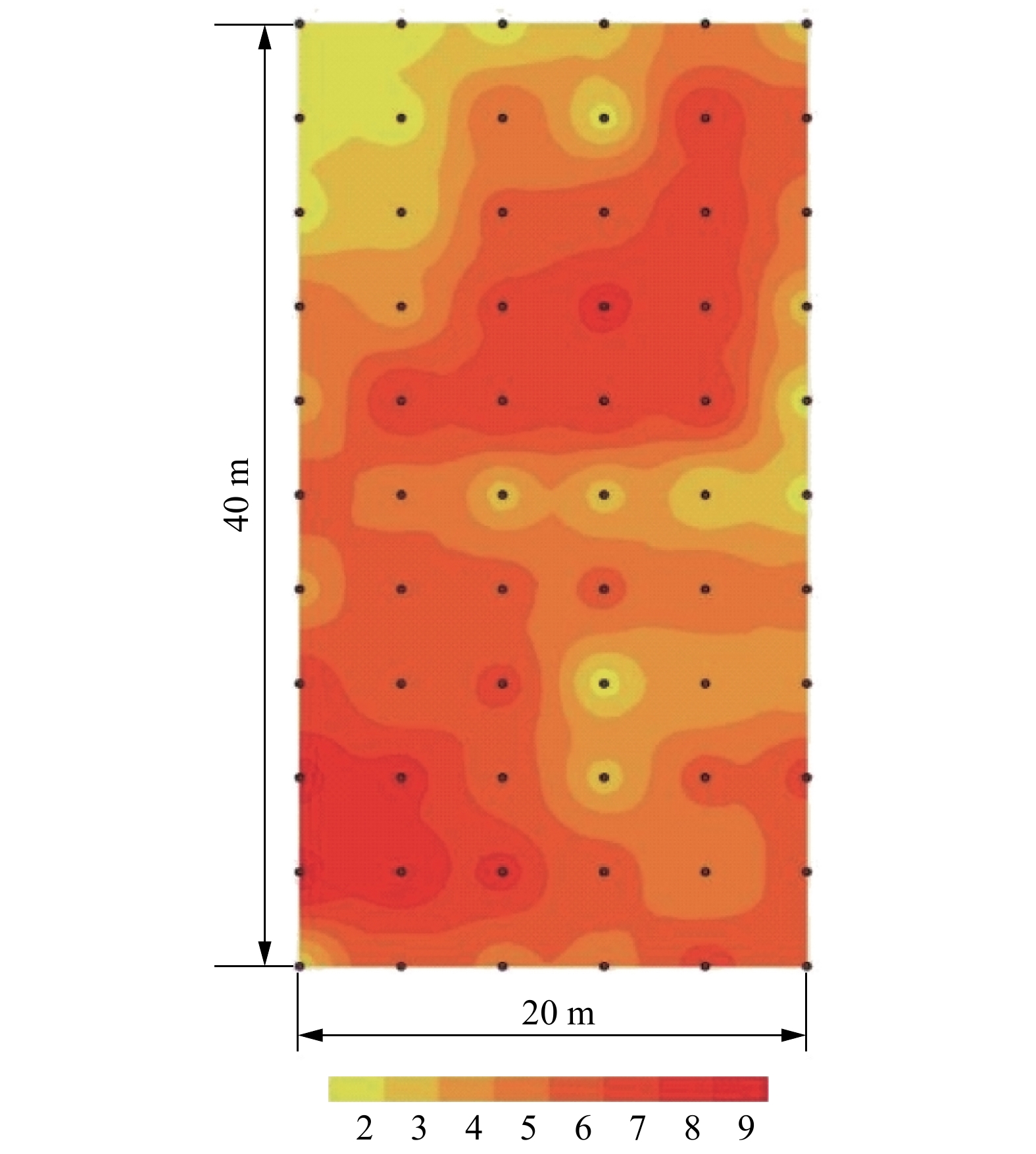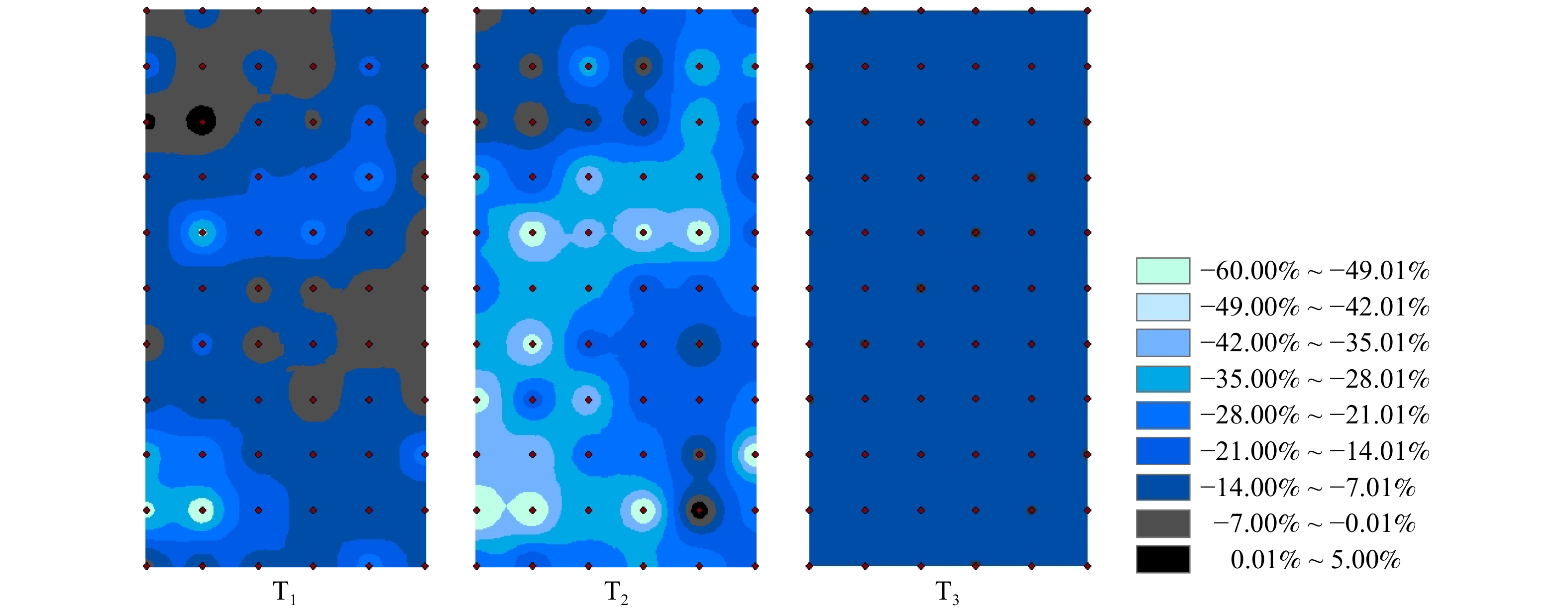Spatiotemporal variations of soil moisture content in the Larix gmelinii forest under interference of experimental forest fire in northern Great Xing’an Mountains of northeastern China
-
摘要:目的 跟踪量化轻、中、重度火干扰下兴安落叶松林土壤含水率,定点分析其时空变化规律与火烧强度干扰差异,深入探讨其形成机制;旨在清楚地认识高寒区火干扰森林生态系统恢复初期土壤水分变化对植被恢复的影响力,并为其调控提供参考。方法 采用网格法确定固定点位并实施林火干扰试验,根据火烧强度等级划分轻、中、重度火烧区,烘干法跟踪监测火烧前、火烧后、翌年融雪季后、翌年生长季土壤含水率。结果 林火干扰后:(1)轻、中、重度火烧区土壤含水率立即下降,春旱时段进一步大幅下降,生长季迅速回升;(2)生长季前重度火烧区土壤含水率显著低于轻、中度火烧区,生长季火烧强度干扰差异消失;(3)生长季前,土壤含水率及其相对变化率的空间格局与火烧强度空间格局极显著负相关。结论 寒温带针叶林火干扰生态系统恢复初期,春旱时段重度火烧迹地土壤含水率可能限制植被更新和再生,应加强集水保水技术调控。Abstract:Objective The spatiotemporal changes of soil moisture content under different fire intensities were analyzed by sequentially monitoring at the fixed points in the mild-, moderate-, severe-burned area of the Larix gmelinii forest, and the forming mechanism was discussed in order to understand the effects of soil moisture variation on vegetation restoration and provide references for artificial regulation in the early years after forest fire.Method The fixed monitoring points were conducted by latticed co-coupled sampling method, then set fire. The burned sample plots were divided into the mild-, moderate-, severe-burned according to the fire intensity class, and soil moisture content was determined by the oven drying method before the burning, afer the burning, following the snowmelt season, and in the growing season, respectively.Result After the fire, (1) soil moisture content decreased immediately in the mild-, moderate-, severe-burned area following the burning, further decreased sharply in the next spring, and rose in the growing season. (2) Soil moisture content in the severe-burned area was significantly lower than those in the mild-, moderate-burned area before the growing season, and no difference was found among the three areas in the growing season. (3) There was significantly negative correlation between the spatial pattern of soil moisture content or its relative change and fire intensity before the growing season.Conclusion In the early years of post-fire coniferous forest restoration in the cold temperate zone, soil moisture content maybe limit vegetation restoration and regeneration in the severe-burned area in spring, and the regulation of rainwater harvesting and water conservation should be strengthened.
-
-
图 2 土壤含水率在火烧时间序列上的变化
大写字母表示某一火烧区各时间节点之间土壤含水率差异显著性(P < 0.05),小写字母表示某一时间节点各火烧区之间土壤含水率差异显著性(P < 0.05)。T0表示火烧试验前1 d;T1表示火烧试验后1 d;T2表示翌年融雪季后;T3表示翌年生长季。下同。In the same fire intensity area, significant differences (P < 0.05) among soil moisture contents at different time points are marked with captial latters; at the same time point, significant differences (P < 0.05) in soil moisture content among varied fire areas are marked with lowercase letters. T0, the day before the burning; T1, the day after the burning; T2, after the next snowmelt season; T3, the next growing season. The same below.
Figure 2. Changes in soil moisture content on the fire time series
表 1 兴安落叶松林野外点烧试验火强度等级
Table 1 Fire intensity classes of burning experiment in the Larix gmelinii forest
火烧强度等级
Fire intensity class火烧强度等级划分标准
Classification standard of fire intensity class赋值
Assigned value轻度(仅地上植被过火,凋落物层完好)
Mild-intensity (only the ground vegetation is scorched or burned out, and the soil organic litter layer was not disturbed)地上植被过火50%以下,凋落物层完好
Less than 50% ground vegetation is scorched, and the litter layer is intact2 地上植被过火50%以上,凋落物层完好
More than 50% ground vegetation is scorched or burned out, and the litter layer is intact3 中度(地上植被全部过火或烧焦,凋落物层未完全烧尽)
Moderate-intensity (all ground vegetation scorched or burned out, and the litter layer combusted incompletely)凋落物层厚度损失1/3以下
Loss thickness of litter layer is less than 1/34 凋落物层厚度损失1/3 ~ 2/3
Loss thickness of litter layer is between 1/3 and 2/35 凋落物层厚度损失2/3以上
Loss thickness of litter layer is more than 2/36 重度(地上植被全部过火或烤焦,凋落物层烧尽,土壤腐殖质表层不同程度燃烧或烧焦)
Severe-intensity (all ground vegetation is scorched or burned out, litter layer is completely burned out, and the humus surface layer of soil is burned or scorched to a certain degree)腐殖质层损失0.5 cm以下
Humus layer loss is less than 0.5 cm7 腐殖质层损失0.5 ~ 1.0 cm
Humus layer loss is 0.5−1.0 cm8 腐殖质层损失1.0 cm以上
Humus layer loss is more than 1.0 cm9 注:此表引自文献[21]。Note: this table is cited from reference [21]. 表 2 火烧时间序列上土壤含水率成对样本t检验
Table 2 Soil moisture content on the fire time series by paired-samples t test
采样时间
Sampling time火烧时间序列上土壤含水率成对样本t检验P值
P value of t test in paired samples of soil moisture content on the fire time series轻度火烧区
Mild-intensity burned area中度火烧区
Moderate-intensity burned area重度火烧区
Severe-intensity burned areaT0 T1 T2 T3 T0 T1 T2 T3 T0 T1 T2 T3 T0 T1 0.000** 0.000** 0.000** T2 0.000** 0.000** 0.000** 0.000** 0.000** 0.000** T3 0.000** 0.005** 0.006** 0.000** 0.661 0.000** 0.000** 0.000** 0.000** 注:**表示成对样本t检验结果极显著(P < 0.01)。Note:** means extremely significant differences (P < 0.01) in t test results of paired samples. 表 3 时间序列上土壤水分特征与火烧强度相关性分析
Table 3 Correlation analysis between soil moisture characteristics and fire intensity on the time series
时间序列
Time series土壤含水率与火烧强度相关性
Correlation between soil moisture content and fire intensity土壤含水率变化与火烧强度相关性
Correlation between soil moisture content change and fire intensity相关系数 Correlation coefficient (r) P 相关系数 Correlation coefficient (r) P T0 0.122 0.328 T1 − 0.359 0.003** − 0.759 0.000** T2 − 0.552 0.000** − 0.695 0.000** T3 0.126 0.314 0.083 0.509 注:**表示土壤含水率及其相对变化率与火烧强度显著相关(P < 0.01)。Note: ** means significant correlations between soil moisture content or its relative changing rate and fire intensity at P < 0.01 level. -
[1] 吕爱锋, 田汉勤, 刘永强. 火干扰与生态系统的碳循环[J]. 生态学报, 2005, 25(10):2734−2743. doi: 10.3321/j.issn:1000-0933.2005.10.040 Lü A F, Tian H Q, Liu Y Q. State-of-the-art in quantifying fire disturbance and ecosystem carbon cycle[J]. Acta Ecologica Sinica, 2005, 25(10): 2734−2743. doi: 10.3321/j.issn:1000-0933.2005.10.040
[2] 许鹏波, 屈明, 薛立. 火对森林土壤的影响[J]. 生态学杂志, 2013, 32(6):1596−1606. Xu P B, Qu M, Xue L. Effects of forest fire on forest soils[J]. Chinese Journal of Ecology, 2013, 32(6): 1596−1606.
[3] 孔健健, 杨健. 林火对大兴安岭落叶松林土壤性质的短期与长期影响[J]. 生态学杂志, 2014, 33(6):1445−1450. Kong J J, Yang J. Short- and long-term effects of fire on soil properties in a Dahurian larch forest in Great Xing’ an Mountains[J]. Chinese Journal of Ecology, 2014, 33(6): 1445−1450.
[4] Turner M G. Disturbance and landscape dynamics in a changing world[J]. Ecology, 2010, 91(10): 2833−2849. doi: 10.1890/10-0097.1
[5] Certini G. Effects of fire on properties of forest soils: a review[J]. Oecologia, 2005, 143(1): 1−10. doi: 10.1007/s00442-004-1788-8
[6] Robichaud P R. Fire effects on infiltration rates after prescribed fire in Northern Rocky Mountain forests, USA[J]. Journal of Hydrology, 2000, 231−232: 220−229.
[7] González-Pérez J A, González-Vila F J, Almendros G, et al. The effect of fire on soil organic matter: a review[J]. Environment International, 2004, 30(6): 855−870. doi: 10.1016/j.envint.2004.02.003
[8] 胡海清. 林火生态与管理[M]. 北京: 中国林业出版社, 2005: 93−103. Hu H Q. Forest ecology and management[M]. Beijing: China Forestry Publishing House, 2005: 93−103.
[9] 孙铭隆. 呼中和南翁河保护区火烧迹地土壤性质及细根生物量研究[D]. 哈尔滨: 东北林业大学, 2011: 14. Sun M L. The reserch of the soil physic-chemical properties and fine root in burned areas of Huzhong and Nanwenghe Conservation[D]. Harbin: Northeast Forestry University, 2011:14.
[10] 张玉红, 孙铭隆, 刘彤. 林火对大兴安岭典型植被土壤理化性质的影响[J]. 东北林业大学学报, 2012, 40(6):41−43. doi: 10.3969/j.issn.1000-5382.2012.06.011 Zhang Y H, Sun M L, Liu T. Effect of forest fire on soil physical and chemical properties of typical forests in Daxing'an Mountains[J]. Journal of Northeast Forestry University, 2012, 40(6): 41−43. doi: 10.3969/j.issn.1000-5382.2012.06.011
[11] 宋利臣, 何平平, 崔晓阳. 重度林火对大兴安岭土壤生境因子的影响[J]. 生态学杂志, 2015, 34(7):1809−1814. Song L C, He P P, Cui X Y. Effects of severe forest fire on soil habitat factors in Greater Xing’an Mountains[J]. Chinese Journal of Ecology, 2015, 34(7): 1809−1814.
[12] 孙龙, 赵俊, 胡海清. 中度火干扰对白桦落叶松混交林土壤理化性质的影响[J]. 林业科学, 2011, 47(2):103−110. Sun L, Zhao J, Hu H Q. Prediction on the changes of forest fire danger rating in Great Xing’an Mountain region of Northeast China in the 21st century under effects of climate change[J]. Scientia Silvae Sinicae, 2011, 47(2): 103−110.
[13] Muqaddas B, Chen C, Lewis T. Temporal dynamics of carbon and nitrogen in the surface soil and forest floor under different prescribed burning regimes[J]. Forest Ecology and Management, 2016, 382: 110−119. doi: https://doi.org/10.1016/j.foreco.2016.10.010
[14] 杨光, 舒立福, 邸雪颖. 气候变化影响下大兴安岭地区21世纪森林火险等级变化预测[J]. 应用生态学报, 2012, 23(5):3236−3242. Yang G, Shu L F, Di X Y. Prediction on the changes of forest fire danger rating in Great Xing’an Mountain region of Northeast China in the 21st century under effects of climate change[J]. Chinese Journal of Applied Ecology, 2012, 23(5): 3236−3242.
[15] 李飞, 胡同欣, 赵彬清, 等. 大兴安岭火烧迹地凋落物分解动态变化研究[J]. 森林工程, 2018, 34(5):31−20. Li F, Hu T X, Zhao B Q, et al. The influence on forest soil’s nature and tree’s regeneration for forest fire in the big Xingan Maient[J]. Forest Engineering, 2018, 34(5): 31−20.
[16] 宋雨, 胡海清, 孙龙, 等. 大兴安岭不同坡位地表可燃物含水率的动态变化与建模[J]. 森林工程, 2017, 33(5):1−7. Song Y, Hu H Q, Sun L, et al. Dynamic change and modeling of moisture content of surface fuel in different slope positions of Daxing’anling[J]. Forest Engineering, 2017, 33(5): 1−7.
[17] 项凤武. 大兴安岭北部林火对森林土壤的性质及林木更新的影响[J]. 吉林林学院学报, 1990, 6(1):1−20. Xiang F W. The influence on forest soil’s nature and tree’s regeneration for forest fire in the Big Xingan Maient[J]. Journal of Jilin Forestry Institute, 1990, 6(1): 1−20.
[18] 王海淇, 郭爱雪, 邸雪颖. 大兴安岭林火点烧对土壤有机碳和微生物量碳的即时影响[J]. 东北林业大学学报, 2011, 39(2):72−76. doi: 10.3969/j.issn.1000-5382.2011.05.023 Wang H Q, Guo A X, Di X Y. Immediate changes in soil organic carbon and microbial biomass carbon after an experimental fire in Great Xing’an Mountains[J]. Journal of Northeast Forestry University, 2011, 39(2): 72−76. doi: 10.3969/j.issn.1000-5382.2011.05.023
[19] 谷会岩, 金靖博, 陈祥伟, 等. 不同火烧强度林火对大兴安岭北坡兴安落叶松林土壤化学性质的长期影响[J]. 自然资源学报, 2010, 25(7):1114−1121. Gu H Y, Jin J B, Chen X W, et al. The long-term impacts on chemical properties of <italic>Larix gmelinii</italic> forest on the northern slope of Greater Hinggan Mountains from a forest fire of varying fire intensity[J]. Journal of Northeast Forestry University, 2010, 25(7): 1114−1121.
[20] 孙明学, 贾炜玮, 吴瑶. 大兴安岭北部地区林火对土壤化学性质的影响[J]. 东北林业大学学报, 2009, 37(5):33−35. Sun M X, Jia W W, Wu Y. Effect of forest fire on soil chemical properties in northern Daxing’an Mountains[J]. Journal of Northeast Forestry University, 2009, 37(5): 33−35.
[21] Cui X Y, Gao F, Song J F, et al. Changes in soil total organic carbon after an experimental fire in a cold temperate coniferous forest: a sequenced monitoring approach[J]. Geoderma, 2014, 226−227: 260−269.
[22] 张韫, 李传波, 崔晓阳. 大兴安岭北部试验林火干扰下土壤密度的时空变化[J]. 北京林业大学学报, 2018, 40(6):48−54. Zhang Y, Li C B, Cui X Y. Temporal and spatial variations of soil bulk density by experimental forest fire in Daxing’an Mountains[J]. Journal of Beijing Forestry University, 2018, 40(6): 48−54.
[23] 张韫, 于悦, 崔晓阳. 试验林火干扰下兴安落叶松林土壤有效磷的时空变化[J]. 北京林业大学学报, 2019, 41(2):12−18. doi: 10.13332/j.1000-1522.20180129 Zhang Y, Yu Y, Cui X Y. Temporal and spatial change patterns on soil available phosphorus by an experimental forest fire in <italic>Larix gmelinii</italic> forests[J]. Journal of Beijing Forestry University, 2019, 41(2): 12−18. doi: 10.13332/j.1000-1522.20180129
[24] 张万儒, 杨光滢, 屠星南, 等. 中华人民共和国林业行业标准: 森林土壤分析方法[S]. 北京: 中国标准出版社, 1999: 13−15. Zhang W R, Yang G Y, Tu X N, et al. The forestry industry standard of China-forest soil analysis method[S]. Beijing: Standards Press of China, 1999: 13−15.
[25] 张韫, 李响, 张帆, 等. CO<sub>2</sub>升高对红松幼苗水分生理特征与土壤含水率变化的影响[J]. 北京林业大学学报, 2015, 37(1):37−41. Zhang Y, Li X, Zhang F, et al. Effects of elevated CO<sub>2</sub> on physiological characteristics of water in <italic>Pinus koraiensis</italic> seedlings and soil moisture in a controlled environment[J]. Journal of Beijing Forestry University, 2015, 37(1): 37−41.
[26] 孙向阳. 土壤学[M]. 北京: 中国林业出版社, 2005: 159. Sun X Y. Soil science[M]. Beijing: China Forestry Publishing House, 2005: 159.
[27] 司国佐, 毛正国, 杨文娟. 大兴安岭地区水文特征分析[J]. 黑龙江水利科技, 2006, 34(6):78−79. doi: 10.3969/j.issn.1007-7596.2006.06.038 Si G Z, Mao Z G, Yang W J. Hydrology characteristic analysis in the Great Xing ’an Mountains[J]. Heilongjiang Science and Technology of Water Conservancy, 2006, 34(6): 78−79. doi: 10.3969/j.issn.1007-7596.2006.06.038
[28] 张可扬, 李天权, 曲延浩, 等. 大兴安岭地区降水量和气温变化趋势分析[J]. 森林工程, 2018, 34(5):8−14. doi: 10.3969/j.issn.1006-8023.2018.05.002 Zhang K Y, Li T Q, Qu Y H, et al. Analysis of precipitation and temperature change in the Daxing'anling area[J]. Forest Engineering, 2018, 34(5): 8−14. doi: 10.3969/j.issn.1006-8023.2018.05.002
[29] 中国农业百科全书总编辑委员会农业气象卷编辑委员会. 中国农业百科全书·农业气象卷[M]. 北京: 中国农业出版社, 1986: 257. Editorial Board of the Agro-Meteorology Volume in Encyclopedia of Chinese Agriculture. The agro-meteorology volume of encyclopedia of Chinese agriculture[M]. Beijing: China Agriculture Press, 1986: 257.
[30] 赵秀兰, 邹立尧. 黑龙江省农田土壤蓄水量盈亏值时空变化规律研究[J]. 中国农业气象, 2003, 24(3):44−47. doi: 10.3969/j.issn.1000-6362.2003.03.014 Zhao X L, Zou L Y. Study on the temporal and spatial changes of surplus-deficit status of soil water storage capacity in farmland in Heilongjiang Province[J]. Chinese Journal of Agrometeorology, 2003, 24(3): 44−47. doi: 10.3969/j.issn.1000-6362.2003.03.014
-
期刊类型引用(1)
1. 姜泽明,周甜甜,卜洪洋,张力平,孙素琴,马芳. 落叶松树皮原花青素生产过程的红外光谱分析. 光谱学与光谱分析. 2018(01): 62-67 .  百度学术
百度学术
其他类型引用(2)




 下载:
下载:



